- Obviousness Essays: Lewis & Clark has published results from its Obviousness symposium. [LINK] Papers include Duffy’s thoughts that the timing of an invention helps determine its obviousness; Mandel’s argument that KSR stinks because it does not truly account for hindsight bias; Eisenberg’s predictive analysis of KSR’s impact on pharmaceutical patent protection; and Miller’s suggestion on how courts should determine PHOSITA’s skill level.
- Prior Art blog discusses Little League Trademark Infringement. [LINK]
- Director Dudas Responds to Congressional Critics [File Attachment: dudas.ltr.pdf (2048 KB)]
June 2008
Obvious to Try? BIO Challenges Ex Parte Kubin
In re Kubin (Fed. Cir. 2008)
Immunex (a subsidiary of Amgen) is hoping to patent its a DNA sequence coding for a NK (Natural Killer) cell regulator protein. The BPAI rejected the “nucleic acid molecule” claim — finding it obvious over the prior art. [BPAI Decision]. This decision is one of only three precedential BPAI decisions in 2007.
Just looking at the claimed sequence, it would not seem obvious — its structure is not overly similar to other regulator proteins, and the unpredictable nature of protein folding makes it virtually impossible to predict whether a particular sequence would code for an appropriate protein.
Despite the structural uniqueness, the BPAI found the claim obvious because it could have been isolated and verified simply by following conventional laboratory techniques — thus, making it obvious to try.
Although the CAFC has previously warned the BPAI away from using “obvious to try” analysis in its 1995 In re Deuel case. There, the appellate court held that obviousness analysis of a structure should focus on the structure itself as compared to prior art structures.
In Kubin, the BPAI rejected Deuel as limited by the Supreme Court’s KSR decision. That case focused on combination claims, but included the stray quote that “the fact that a combination was obvious to try might show that it was obvious under Section 103.”
Here, the BPAI argued, the inventor wanted to isolate the NK Regulator and simply used known methods to do so. “Thus, isolating NAIL cDNA was ‘the product not of innovation but of ordinary skill and common sense.’” (again quoting KSR).
The case is now on appeal at the the CAFC. On June 10, the Biotechnology Industry Organization filed an amicus brief asking the court to cabin in the scope of KSR and hold that its obvious to try dicta does not abrogate the Deuel standard. Briefing is ongoing and a decision is not expected until the end of the year.
- Download kubin.amicus.pdf
- The PTO’s Obviousness Guidelines have the following rules for making an obviousness rejection based on the obvious to try reasoning:
- (1) a finding that at the time of the invention, there had been a recognized problem or need in the art, which may include a design need or market pressure to solve a problem;
- (2) a finding that there had been a finite number of identified, predictable potential solutions to the recognized need or problem;
- (3) a finding that one of ordinary skill in the art could have pursued the known potential solutions with a reasonable expectation of success; and
- (4) whatever additional findings based on the Graham factual inquiries may be necessary, in view of the facts of the case under consideration, to explain a conclusion of obviousness.The BPAI decision is notable for a few reasons, including the following two: (1) It was written by Nancy Linck, former PTO Solicitor, Newman law clerk, & PhD Chemist. Soon after authoring the decision, Linck left the firm to join the Rothwell Figg firm. (2) It is a unanimous opinion.
Appellate Court Affirms that Generic Omeprazole does not Infringe Prilosec Patent
IN RE OMEPRAZOLE PATENT LITIGATION (Fed. Cir. 2008) (nonprecedential)
Omeprazole is the active ingredient in the best-selling drug Prilosec. Mylan and others challenged Astrazeneca’s patents on grounds that their generic formulations do not infringe two Astra’s listed patents. “After a forty-two day bench trial,” a Southern District of New York district court agreed that the generic formulation do not infringe. On appeal was the question of whether the generic versions contained an “alkaline reacting compound” (ARC) as required by the claims.
Using the Specification as Proof of Non-Infringement: Astra argued that the talc used by the generic products included an ARC. The CAFC agreed that the lower court had properly rejected that argument based in part on language in the specification. Specifically, the nearly identical specifications listed several different ARCs but did not include talc on the list. “In contrast, the specifications also lists a number of ordinary excipients, among which is talc. . . Thus, the specifications themselves indicate that ARCs do not include talc.”
Defying conventional wisdom at the time, Mylan launched its generic version of Omeprazole in 2003 — despite ongoing patent litigation.
Non-infringement affirmed.
Certificate of Correction
According to PTO figures, the Office has issued around 25,000 certificates of correction on issued patents each year since 2001. On a per patent basis, about 15% of issued patents are associated with a certificate of correction.*
Generally, a certificate of correction can be used to correct a minor mistake such as a “clerical or typographical” error or other minor error. In Superior Fireplace, the court held that a certificate of correction that broadens the claim is only permissible when it is clear from the specification and prosecution history how to correct the error. Similarly, in Central Admixture Pharmacy the CAFC found that the correction from osmolarity to osmolality was void because the error “was not clearly evident to one of skill in the art and the result was to broaden the claims.” The relief for an improper certificate of correction is simply to cancel the certificate.
Over the past several years, a number of automated and out-sourcing services have emerged to check against PTO printing errors and other typographical errors. What are the best services and best practices regarding corrections?
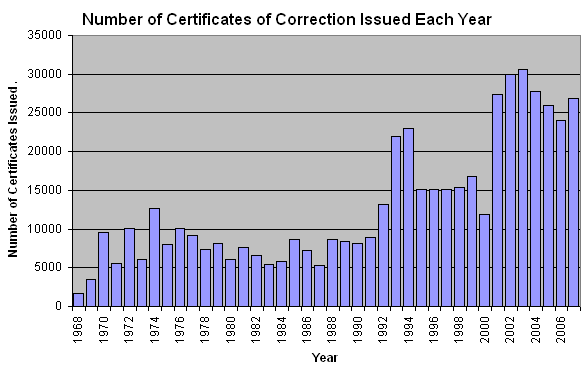
- * To account for the time delay in obtaining corrections, I looked at only patents numbered 6,000,000 – 7,000,000 for the per patent estimate.
Auto Parts Design
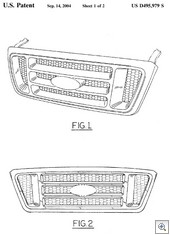
In 2007, the International Trade Commission (ITC) issued a final decision finding three Ford design patents invalid based on a prior public use. The patents relate to various parts of its F-150 truck design. Ford had asked the ITC to stop generic parts manufacturers from imports of the patented designs that were flowing in from Taiwan. In its decision, the ITC found seven of the design patents valid and infringed, but found that three of them were invalid.
Prior Public Use: The alleged prior public use in this case was an event where Ford selected 900 members of the public to attend in small groups and provide feedback on proposed car designs. At the event, security was “high,” cameras were banned as were sketches. Thus, according to Ford, the attendees could not have truly disclosed the ornamental features of the patented design. The invitees were also paid – and thus, disclosure to those individuals should be presumptively be considered private (as would normal in house discussions with an employee). Ford also argues that the payment to attendees is clear evidence that this public use was not “commercial exploitation.”
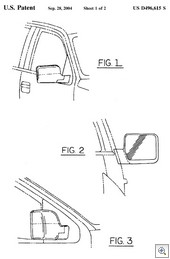
Ford embraced the narrow scope of its design rights – arguing that there its controls over the feedback event of preventing cameras or drawings ensures that none of the attendees will be able to place the invention in the public domain. Notably, in a recorded post-show follow-up, attendees who were asked about the design could only describe it in general terms such as “beefy.”
“The video evidence shows that the claimed ornamental features of the patents-in-suit were not in the public’s possession. Without cameras or sketches – which were specifically prohibited – there was no way here that the claimed designs could have been disclosed to the public. Ford therefore did not “remov [e] inventions from the public domain which the public justifiably comes to believe are freely available.” … In short, “beefy front end” and “a chopped top” do not describe or disclose the design inventions.

“[E]ven though the court compares two items through the eyes of the ordinary observer, it must nevertheless, to find infringement, attribute their similarity to the novelty which distinguishes the patented device from the prior art.”‘ Lawman, 437 F.3d at 1386 (quoting Litton, 728 F.2d at 1444).
The defendants are correct that Lawman and Litton appear to require the point-of-novelty test in every case of infringement. That issue will likely be resolved in the upcoming en banc decision in Egyptian Goddess. In addition, the defendants argued that the design patents should be considered obvious under KSR v. Teleflex (2007). As in that case the claims appear to be composed of a set of elements all found in the prior art.
An amicus brief was filed supporting the generic manufacturers. However, I have not yet seen that brief. In addition, the ITC recently began investigating another design patent complaint filed by Ford against the same generic manufacturers. This new case involves repair parts for the 2005 Mustang redesign.
Note:
- A reader reminded to me to mention pending H.R. 5638 and the PTO’s town hall meeting next Monday to discuss design patent issues. (written comments due July 15).
- Unlike the patent reform bill, H.R.5638 is a partisan Democrat sponsored bill that would primarily support the insurance industry and make automobile repair less expensive by excusing repair parts from patent infringement. The bill would amend 35 USC 271 by adding the following subsection:
- (j) It shall not be an act of infringement to make, use, offer to sell, or sell within the United States or import into the United States any article of manufacture that itself constitutes a component part of another article of manufacture, if the sole purpose of the component part is for the repair of the article of manufacture of which it is a part so as to restore its original appearance.
Patently-O Bits and Bytes No. 42: Two requests for help
- What is the best way to search for reexamination certificates? Are these available through the PTO site?
- Does anyone have a good process flowchart for a university tech-transfer operation?
- Thanks! dcrouch@patentlyo.com
Existence of Non-Asserted Claims Allows Court to Disregard Construction Canon Encouraging Coverage of Preferred Embodiment
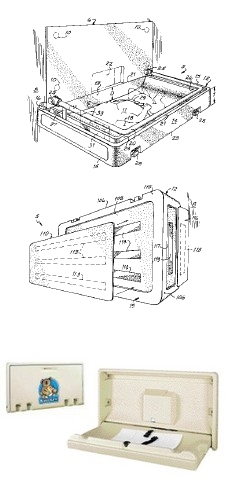
John Helmsderfer sued Bobrick for infringement of its patent covering tamper-resistant diaper changing stations. After a markman hearing, the Southern District of Ohio district court awarded the defendants summary judgment of non-infringement. Helmsderfer appeals on claim construction.
Partially Hidden from View: The claims include a top surface platform that is “partially hidden from view.” On appeal, the patentee argued that “partially hidden” could include “totally hidden.” The CAFC disagreed for two textual reasons:
- The patent used “generally” in other portions of the claim but not for this element — providing evidence that the patentee was intentionally distinguishing between those two modifiers.
- The patent used “at least” in other portions of the claim but not for this element — providing evidence that in this case the patentee did not intend to claim “at least partially.”
Quoting its own 2000 CAE Screenplates decision, the court reasoned that “[i]n the absence of evidence to the contrary, we must presume that the use of these different terms in the claims connotes different meanings.” Here, the court could find no evidence to find that partially should include totally.
Exclusion of preferred embodiment: The applicant did point that its preferred embodiment and also “every illustrated embodiment” would be excluded by the narrow definition of “partially hidden.” The CAFC, however, rejected that such an exclusion creates any problem here. In particular, the court noted that it was analyzing only teh two claims (6–7) at issue in the case — “[O]ur construction of claims 6–7 leaves open the possibility that claims not at issue in this appeal encompass omitted embodiments. It is often the caes that different claims are directed to and cover different disclosed embodiments. The patentee chooses the language and accordingly the scope of his claims.”
The appellate panel gave lip service to the precedential canon of avoiding claim interpretation that “excludes the preferred embodiment from the scope of the invention.” However, in the end the court gave absolutely no weight to that “caution” in its claim interpretation. Rather, the decision notes the distinction between the patent as a whole and the particular asserted claims. In this case, the court noted that other claims are included in the patent and that those may be the ones that cover the preferred embodiment.
This interpretation falls on the heels of the PSN Illinois v. Ivoclar Vivadent holding that sometimes unasserted or cancelled claims directed to a particular disclosed embodiment may actually serve as evidence that the scope of the asserted claims does not extend to that embodiment. PSN Illinois – written by Judge Michel – applies the sensible notion that non-asserted or cancelled claims should be examined to determine if the preferred embodiment is found there. Helmsderfer extends that notion by creating an apparent presumption that – if non-asserted claims exist, then the court need not consider the rule of construction that encourages encompasing preferred embodiments.
Notes:
- Preferred Embodiment: Relation to Tafas v. Dudas: Although the patentee lost here, Judge Moore’s decision here creates some interesting support for the Tafas case – by holding that it is the patentee’s right to file alternative claims to cover various parts of the disclosed embodiment.
- Drafting Thoughts: Non-numeric range limitations – such as “partially” – have benefits and potential liabilities. When including a limitation of this type, you may do well to consider what prior art you are attempting to avoid — and consequently claim either “at least partially” or “at most partially.”
Patently-O Bits and Bytes No. 41 (False Marking, Etc.)
Tracking Appeals: There is an interesting new patent litigation blog: Patent Appeal Tracker run by Kyle Fleming and Josh Ryland. They are providing a review of various pre-decision appeals.
- False Marking: Matthew Pequignot is again a plaintiff in a false marking action under 25 USC 292. He has now teamed with two plaintiffs firms and filed suit in the Eastern District of Texas against Gillette and its parent company P&G. The complaint specifies 683 counts of false marking and requests the maximum $500 per “offense.” The falsity of the marking appears to be generally summarized as either (1) marking products with expired patent numbers and (2) marking products with patents whose scope do not cover the products. On the second point, some of the counts allege that the defendants marked products with patents covering a method of manufacture when the product was not manufactured according to the patent. [LINK]
- False Marking Comment: There are three primary reasons to mark products with the associated patent number. (1) Legally, marking provides evidence of constructive knowledge that can increase a patentee’s damages. (2) Apart from the damage issue, the patent can also serve as at least a low-level deterrent to chill would be competitors. It will at least cost several thousand dollars to hire a patent attorney to figure out if the patents are expired. (3) Finally, the patent provides additional market credibility to customers (and perhaps investors). Continued listing of an expired patent would continue to benefit the manufacturer in the last two points — and consequently help the manufacturer maintain its market position. The key point of contention will be whether the listings were made “for the purpose of deceiving the public” as required by the statute.
- Moving Forward on False Marking: If this type of litigation continues to grow, in house counsel should consider creating a system for ensuring that expired and invalid patents are no longer marked on company products. A system — even if a bit leaky — will likely serve as a good defense against false marking charges because they provide evidence of a lack of intent to deceive the public.
- Patent Law Jobs:
Ex Parte Reexamination Statistics I
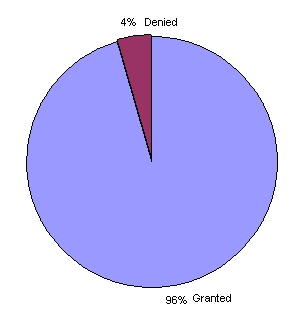
Standing alone, this denial does not appear to be big news — except for the fact that over 95% of requests for ex parte reexamination are granted. In FY 2003–07, for instance, the PTO reviewed 2389 requests for ex parte reexamination and only denied the request in 105 cases. (4.4%). (At this point, there is some possibility that the denials are procedural as the documents are not yet available on PAIR).
To be granted, a reexamination request must present a “substantial new question of patentability” that affects at least one claim of a patent. The request must be based on a prior art patent or publication. Prior public use or sale are not admissible as evidence in an ex parte reexamination proceeding (although affidavits explaining the prior art publications is admissible).
In general, there has been a rise in requests for ex parte reexamination. As the chart below demonstrates, increase is entirely due to an increase in requests for reexamination that are filed by third parties.
- Statistics are from the USPTO Annual Report FY 2007 and other annual reports.
- Avistar News Story
- IPRIORI keeps ex parte reexamination data continually updated here [LINK]
Some Design Patents That Have Been Litigated
Subsidiary’s Lost Profits Do Not Translate to Lost Profit Damages for Parent Patent Holder
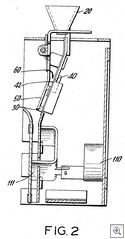
Way back in 1990, Mars sued CoinCo for patent infringement — asserting two patents covering technology for authenticating coins inserted into a vending machine. Eighteen years later, the parties are still battling over damages.
Lost Profits: In this decision, the CAFC affirmed that the Mars corporate structure (designed to avoid certain taxes) eliminated the company’s ability to recover damages under a “lost profits” theory. Usually, lost profits are only available when a patentee is a market competitor. Mars itself has never made vending machine coin changers. However, its wholly owned subsidiary, MEI, did operate vending machines and licensed the patents on a non-exclusive per-use basis. Although it was a wholly owned subsidiary, the court found that MEI’s provable lost profits due to the CoinCo infringement did not translate to lost profits for the patentee itself (Mars). Of particular importance was the license structure between MEI and Mars that called for a straight per use license rather than a license based on a measure of profits. Rather, lost profits require a showing that the patent holder itself had lost profits.
This decision can be seen as a continuation of the 2004 Poly-America case where the court held that the patentee could not recover lost profits for damages felt by a sister corporation. Lost profits damages are usually preferred to damages calculated as a reasonable royalty because the lost profit calculation typically results in a larger number.

Curing standing: In patent cases, standing is typically determined at the point that a claim is filed. Here, we have a seeming loss of standing. In the 2005 Schreiber decision, the CAFC held that a “temporary loss of standing during patent litigation can be cured before judgment.” Despite a half-hearted attempt, the court found that Mars had not properly cured its standing because MEI did not transfer complete ownership back to Mars.
Cornell wins $184 Million in Damages for Past Infringement by HP

The patent — No. 4,807,115 — issued in 1989 and expired during the seven years of litigation. It is directed toward an internal computer messaging mechanism that boosts the function of multi-processor computers.
Interestingly, Cornell and HP had discussed a licensing agreement as early as 1988 (even before the patent issued). In 1997, Intel licensed the ‘115 patent for use in its Pentium Pro chips.
Unpublished Thesis: In a pre-trial decision, Judge Rader denied Cornell’s motion in limine and allowed HP to show the jury an unpublished masters degree thesis as 102(b) prior art. The court found the thesis publicly accessible because the thesis had been cited in a later article that was in the same area of technology as the issued patent (analogous art.).
“After weighing all the circumstances of accessibility, this court views as vitally important the citation of this scholarly work in the Tjaden-Flynn article.”
Inventor Rewards: Unlike most companies, universities generally offer a percentage royalty cut for its employee-inventors. Professor Torng, the inventor of the ‘115 patent, will reportedly receive 25% of the award (if it is ever paid). Torng has announced that he’ll only keep a few million and donate the rest (perhaps over $30 million) to charity.
The post-trial decisions and eventual appeal should be interesting.
Question on Provisionals?
- When an issued utility patent claims priority to a provisional patent application, is there a presumption that the claimed invention is supported by the provisional?
- What is wrong with filing claims in a provisional application?
Patently-O Bits and Bytes No. 40
- Sitting by Designation: The CAFC has continued to offer district court judges from across the country the opportunity to sit on the appellate bench for a day. On June 3, 2008, Judge Ward from the Eastern District of Texas filled out a panel with Judges Newman and Gajarsa. They will be deciding three patent cases: Hyatt v. Dudas (waiver of arguments before the BPAI); Atlanta Pharma v. Teva (appeal from denial of preliminary injunction to stop teva from selling a generic version of the ulcer med Protonix); and D Beam v. Roller Derby.
- New USPTO Fees: They are going up, but you can put in your two cents by July 3. [New Fees][Contact Walter.Schlueter@uspto.gov. Include RIN number RIN 0651–AC21 in the subject line.]
- FTC Commissioner Rosch recently spoke about patents and antitrust. He believes that the FTC Act, the Clayton Act and the Sherman Act all create “viable enforcement tools” against companies that create “patent walls” — especially when they acquire those patents from third parties. The FTC is currently going after N-Data in a case where the patent covers an ethernet standard. [N-Data][Zura’s Comments] Three important cases on this issue:
- US v. Singer Mfg (Antitrust violation to charge competitors with patent infringement after U.S. company obtained patent from Swiss company)
- Kobe v. Dempsey Pump (obtaining and using “every important patent” in the field in order to exclude competition, together with other anticompetitive activity, constitutes an antitrust violation)
- Case of Xerox Corp (settlement consent decree where FTC challenged Xerox’s purchase of additional plain paper copier patents).
- Pre-Purchase Review: There is some room to debate here on the question of organic-patenting (patents on inventions via the company’s own R&D) versus acquisitional-patenting (buying up patents invented by others). At the firm level, acquisitional growth is typically reviewed much more harshly for potential antitrust violations than is organic growth. Is the FTC/DOJ headed toward a system of pre-purchase review of major patent acquisitions in the same way that the agencies conduct pre-merger reviews?
A First Look at Who Files Provisional Patent Applications
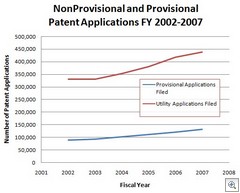
Interestingly, in my study of recently issued patents, only 21% reference a provisional application as a parent. (In the study, I look at approximately 15,000 utility patents issued in April and May 2008.) [2]
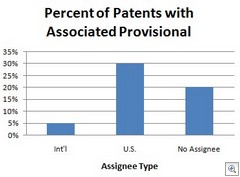
The provisional application provides a potential extra year of patent eligibility at the end of the term. Thus, it is also not surprising that new drug inventions – where a potential year at the end of the term is most valuable – have the highest rate of association with a provisional application.[5] Likewise, patents on electrical and electronic applications had the lowest rate of provisional filing even after excluding the international applications.
The provisional filings appeared to have almost no impact on the pendency time of a patent application as measured by the number of days from filing the nonprovisional to issuance. This makes sense as no examination takes place until the nonprovisional application is filed.
The following table also provides some interesting comparisons of patent strategy.[6]
|
Type of Technology< ?xml:namespace prefix ="" o /> |
Number of Utility Patents in the Sample |
Number of Patents Referencing Provisional Parent |
Assignee |
|
|
Mechanical |
24 |
1 |
4% |
Ford |
|
25 |
13 |
52% |
GM |
|
|
Drugs & Medical |
7 |
4 |
57% |
Wyeth |
|
8 |
7 |
88% |
Genentech |
|
|
11 |
1 |
9% |
Boston Scientific Scimed |
|
|
21 |
10 |
48% |
Medtronic |
|
|
Computers & Communications |
15 |
12 |
80% |
InterDigital |
|
23 |
7 |
30% |
Oracle |
|
|
31 |
11 |
35% |
QUALCOMM |
|
|
44 |
25 |
57% |
Broadcom |
|
|
114 |
16 |
14% |
Microsoft |
|
|
Chemical |
6 |
6 |
100% |
Bristol-Myers Squibb |
|
9 |
4 |
44% |
Procter Gamble |
|
|
10 |
3 |
30% |
3M Innovative Properties |
|
|
14 |
9 |
64% |
EI du Pont de Nemours |
|
|
17 |
0 |
0% |
General Electric[7] |
|
|
17 |
16 |
94% |
Genentech |
[1] This information comes from PTO annual reports for FY 2006 and 2007.
[2] These patents were downloaded on May 30. I excluded the few patents filed prior to the 1995 introduction of provisional patent applications.
[3] In a follow-on study, I will look at published patent applications claiming priority to provisional applications to get some sense of how often folks abandon provisional patent applications.
[4] 6823 were assigned to foreign entity while 6457 were assigned to a U.S. entity. Another 1922 had no listed assignee.
[5] My study included 677 patents having a primary U.S. Classification in a “drug” field and also assigned to a U.S. entity. Of those, 48% were associated with a provisional application.
[6] Note, my assignee ‘scrubber’ is not yet perfect. Thus, it is likely that some patents associated with listed assignees are not included in the table.
[7] Some companies, such as GE hold patents in several different categories – this table looks only at those patents in the particular identified category.
Patently-O Bits and Bytes No 39
- Congratulations to Ryan Swarts! Mr. Swarts was my student in eCommerce Law and has been in charge of the successful Patently-O Job board for the past year … all while running his own company. Ryan recently graduated from MU Law and is now looking to specialize in trademark and copyright law, especially relating to the Internet. Now that he’s a free agent — feel free to contact him directly. [Ryan’s Resume][Contact Ryan].
- June 25–29: The FCBA’s Bench & Bar Conference will be in Silicon Valley area (Monterey) for the first time. Speakers are primarily judges and in-house counsel. [LINK].
- Such As: Contract Specialist Kenneth Adams discusses the recent decision in Lawler Mfg. v. Bradley Corp. and the use of “such as” in contract formation. [LINK][Patently-O discussion of Lawler].
- Egyptian Goddess En Banc: Oral arguments are online.
 Tracking Appeals: There is an interesting new patent litigation blog:
Tracking Appeals: There is an interesting new patent litigation blog: 















